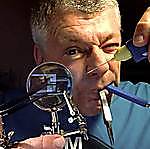
Italeriís new tool 1/32 scale Mirage IIIc attracted me from the moment its release was announced. Iíve recently shifted my modelling focus from armour to aircraft and in the process decided that 1/32 is the scale for me. Having completed kits in smaller scales, Iíve been disappointed at how detail is lost to all but the closest inspection. Iím hoping that a larger scale will leave more of my work visible to viewers not equipped with a magnifying glass, including me. The Mirage is an iconic fighter and one that Iíve loved since I was a boy. All in all, the combination of scale, subject matter and a few good reviews was enough to start me off.
Except that I nearly didnít. I love making kits, but my track record as a blogger is a bit mixed. Frankly, the making takes over from the sharing and Iíve dropped a few blogs, but inspired by others Iíve vowed to keep this one going. I guess thatís my way of saying, please stay with me if things stall a little over time.
The Italeri kit is a mixed bag. Thereís some beautiful detailing alongside very poor moulding. A few examples of both are included in the shots below. Check out the great panel lines and rivet detail...

...and the 1970ís style melted-cheese look at the top of the ejector seat halves.

I expect aftermarket companies are racing to make replacement parts. From the beginning I decide to make the most of the kit and scratch build what I thought needed improving. I enjoy scratch building and while my skills aren't up to those of the after market suppliers, I wanted to test myself and take a Ďgood enoughí approach.
Work started with that cheesy ejector seat. After cleaning up the parts I started researching photos of the real thing to help me improve it. Thereís lots on the internet but it isn't always clear, and different sources don't always agree. I decided to keep one good reference to hand and choose the photo below. By the way, there are already some great blogs out there with links to excellent references, especially on ĎLarge Scale Planesí.

I decided to improve the very basic seat pads, and made a start by constructing some additional padding from plastic card. I glued it in place and added a little detail by cutting and sanding a few folds. The material in my reference looks like leather and foam, so I didn't add fold lines.

In contrast the headrest has clear folds and is very thick. The kit part needs attention, so I increased the size and added those interesting folds using Milliput. My technique is to roll small sausage, place it on the part and then work it into shape using tooth picks and paint brush handles. Once Iím happy I run a wet brush over it to smooth out the shape. Next it will need sanding to blend the filler smoothly to the plastic.


Thatís it for the first instalment. I hope itís enjoyable. Any offers of advice are grateful accepted.
Thanks for looking in, and Merry Christmas!
More work on improving the seat resulted in some lead wire being added to the cushion edges This simulates the piping on the lower seat padding. In addition I added a new slot for the ejection handle made from plastic card, and started enhancing the padding on then back of the seat, this time with soft metal foil. Some left overs from a previous project did the job, which I think started life as a tomato paste tube. You can see the results below.
Happy modelling.
Steve













































